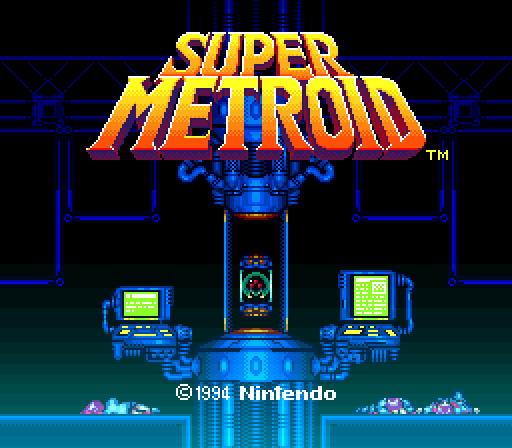SUPER METROID – Critique
|
“The last Metroid is in captivity Super Metroid begins with these iconic* words, spoken by a strangely soothing voice. It’s interesting that Nintendo was willing to woo players with voice acting then, and yet resisted for 13 years before allowing a Metroid game (Metroid Prime 2: Echoes) to feature that again. That intro in Super Metroid is a brilliant piece of foreshadowing. Is the galaxy really at peace? We, of course, know better. Before anything is seen, you hear a Metroid chirp. This is an ominous sound and anyone familiar with the franchise knows how dangerous that it is. Then you get a tight camera pan of some piece of machinery, some computer equipment and dead bodies. Finally, the camera pulls back, and you see the whole facility as well as a sole Metroid pulsating inside its tube. The danger of the Metroid is clear. The last Metroid may be in captivity – but the galaxy certainly isn’t at peace. Super Metroid tells the tale of Samus Aran venturing at the Space Pirates’ Base in Zebes to recover that Metroid Larva from the evil Mother Brain. The Metroid Larva, is the game’s McGuffin: a plot device that motivates the characters, but has little other relevance to the story. The game is really about searching for things: Mother Brain, the Metroid, Power Ups, etc. The game’s mood derives from the atmospheric tunes and Samus’ loneliness (or is her independence?) which feels amplified by her generic goal: to explore a strange planet that follows no structure whatsoever. And that’s the thing about Zebes – it appears to have no logic. The first thing you think after leaving Ceres and entering Zebes is that Zebes isn’t functional as a base. With its chaotically arranged tunnels, large unimportant sections, hard-to-access hubs and control rooms and its frequent dead ends, Zebes doesn’t seem designed for human logic. That sense of strangeness is crucial to the game’s atmosphere. For contrast’s sake, the Biologic Space Laboratories from Metroid Fusion makes much more sense as a functional facility. Zebes never feels like some empty space between items and bosses, unlike The Elder Scrolls IV: Oblivion‘s Tamriel, which is just some space between cities and landmarks, or even Ocarina of Time’s Hyrule Field. Metroid games aren’t really about Samus or her apparent loneliness. They are about the place she’s in. It’s important to note that Zebes may feel weird to us, but not to Samus. Though this isn’t revealed in Super Metroid, she actually grew up in Zebes before the Space Pirates settled in and corrupted it. That corruption theme is constant throughout the entire Metroid franchise and it has appeared in every other Metroid game with the exception of Hunters: if something was good and pure in the past, it’s evil now. Even the old relics of the past are corrupted: the second Chozo Statue you encounter in the game, which symbolized what was untainted by evil, now comes to life and attacks Samus. Nothing is safe anymore. In a surprising twist, Metroids are found to possess powers that could be harnessed for the benefit of mankind. Super Metroid puts the little creatures under a different light. Until then, they were dangerous things that should be destroyed on sight. Here, Samus must save one! Their purpose becomes ambiguous. Are Metroids evil? Should they be judged by the actions of those who manipulate them? We are reminded of the intro sequence: is the Metroid really responsible for what happened around it? In an ironic twist of fate, Samus is the one that’s rescued by the Metroid Larva she was supposed to rescue – and this would happen again in Metroid Fusion. Are Metroids mere monsters acting on instinct? The Metroid Larva showed not only the instinct to protect its “mommy”, but comprehension of her situation as well, hinting that Metroids may actually be aware of what happens to them. Are the Space Federation and the Space Pirates correct in their will to use them as tools and keep them in laboratory confinement? This makes us reevaluate not only that, but Samus’ role as exterminator as well. Before Half Life came, Super Metroid already proved good narratives could be delivered without the use of cutscenes. The result is a hint of authenticity in your reactions. Didn’t you feel a peak of desperation at the first time you played Super Metroid and thought Ridley was going to kill you in Ceres? Evoked narratives are also used, like in the first section of Zebes, which is actually the old Tourian where Samus first encountered Mother Brain. This hint of intertextuality evoke to the player stories that he already knows from the original game. Interestingly enough, the last area of the game Metroid: Zero Mission (a remake of the original Metroid) evokes Super Metroid’s Wrecked Ship area, as that area didn’t feature in the original game. In the end, god comes from the machine in the form of the Hyper Beam, which allows Samus to easily resolve the fix she’s in. With it, she destroys Mother Brain, who falls to the floor and turns to dust. This triggers the traditional self-destruct sequence, but she makes it to her gunship just in time to escape from the planet’s demise. In the end, destruction was the easiest way to cleanse Zebes of its corruption – a nihilistic approach familiar to many Final Fantasy villains. * the word ‘iconic’ is an euphemism, really. If I were to rank my Top Ten Most Memorable Moments in gaming, that phrase would certainly be included. It’s the gaming equivalent to “A Long Time Ago/ in a Galaxy Far, Far Away” that make me cheer at the beginning of every Star Wars picture. |

Pingback: The Friday Post: The Care Bear Cares What You Did « Nightmare Mode